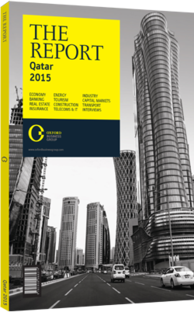Strong economic fundamentals in Qatar bolster many sectors
With oil prices bouncing along the bottom of the charts, and most forecasts suggesting they are likely to stay well submerged for some time, Qatar’s infrastructure project pipeline may now be coming on-stream at a lessthan-opportune time, although the state’s solid economic fundamentals and rapid non-oil growth will help mitigate the worst of the near-term oil shocks, and should keep expansion strong over the mid-term.
Ventures ONSITE, a regional construction project tracking system, estimates Qatar’s infrastructure programme is worth some $280.2bn, with $136.48bn earmarked for buildings, $103.42bn for infrastructure and $40.29bn for energy development. However, for the 2014/15 fiscal year, Qatar had assumed a $65-a-barrel price – significantly higher than current realties.
OIL IMPACT: Qatar is expected to record real GDP growth of 7.1% in 2015, according to Masraf Al Rayan’s March 2015 monthly economic report, although the state will also feel the impact of lower oil prices more keenly than some of its GCC neighbours. The recent IMF report, “Learning to Live with Cheaper Oil amid affected oil-exporting country globally, when it comes to export revenue losses from lower oil prices, after Kuwait. The IMF then went on to predict that the country’s 2014 fiscal surplus of 9.2% of GDP would likely swing to a 1.5% fiscal deficit in 2015. Efficiently managing the financing of this deficit will become a crucial factor in the years ahead, if targets are still to be met on time. The signs are that this management is already under way. Majors such as Qatar Petroleum have begun consolidation, while other government-backed institutions have been tightening their belts. As a result of these efforts and the state’s strong macro-economic fundamentals, Masraf reports that Qatar has witnessed few signs of lower oil prices impacting economic activity.
Consumer confidence also remains strong. MasterCard reported in its consumer confidence index published in November 2014 that Qatar ranked highest across the Middle East, scoring 97.2, with survey respondents reporting they feel “extremely optimistic” across indicators including regular income, employment, quality of life, stock market and economy.
DIVERSIFICATION: Non-oil growth is expected to drive economic expansion, and the government has made it clear that there will be no let up in the project roll out, despite oil market volatility. Well before oil prices dropped, Qatar had moved to achieve sustainable longterm growth via efforts to diversify its income, ownership structure and capabilities. Diversification has been ongoing and saw the value of the non-hydrocarbons sector exceed that of hydrocarbons for the first time in Q3 2014, reaching 50.7% of GDP growth compared to 49% in Q2 2014. Qatar National Bank (QNB) reports that non-oil growth was spurred by investments in infrastructure projects, as well as a fast-expanding population and corresponding growth in consumption.
SOLID POSITION: QNB reports that the oil and gas sector shrunk by 2.8% in Q3 2014, as a result of lower crude oil output and maintenance shutdowns at gas facilities. However, Masraf reported that the state is expected to earn an estimated $372bn from hydrocarbon activities over the next five years. In addition, Qatar has huge financial reserves to fall back on. The IMF report has categorised Qatar’s financial buffers as “substantial” in the short run. The state’s economic position remains extremely strong. The 2013/14 budget surplus reached a record QR115bn ($31.5bn), or 15.6% of GDP, up from QR78.8bn ($21.6bn), or 11.3% of GDP the previous year, and Qatar’s current account surplus stood at 27.6% of GDP as of January 2015, although this is expected to narrow to 16.6% by 2016, according to the National Bank of Kuwait. Above all, however, the management of a deficit budget will require much stricter financial discipline and tougher requirements for decision making in project roll out (see analysis).
The fall in oil prices also highlights the importance of the private sector taking a larger role in the state’s economy, thereby further reducing its dependence on government spending and hydrocarbon revenues.
You have reached the limit of premium articles you can view for free.
Choose from the options below to purchase print or digital editions of our Reports. You can also purchase a website subscription giving you unlimited access to all of our Reports online for 12 months.
If you have already purchased this Report or have a website subscription, please login to continue.

